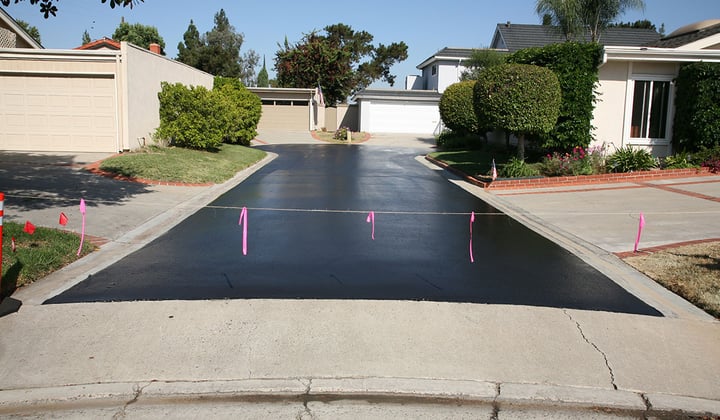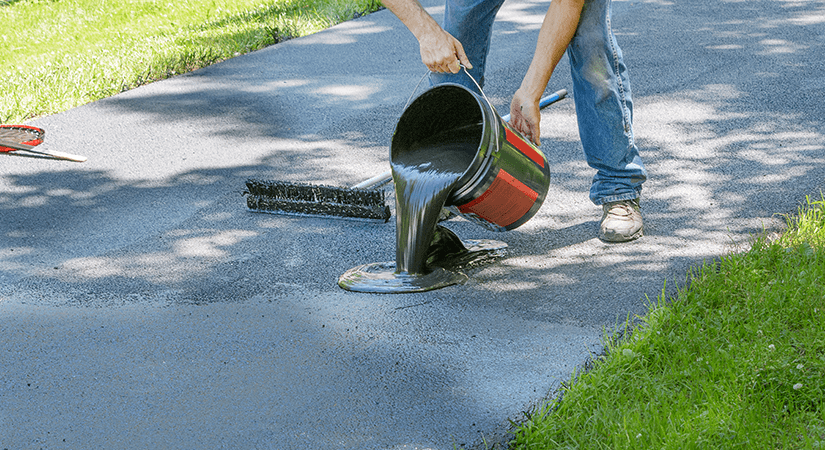Boost Commercial Charm: Hot Mix Asphalt Sealing for Angled Parking Lots
Boost Commercial Charm: Hot Mix Asphalt Sealing for Angled Parking Lots
Blog Article
Hot Mix Asphalt: A Lasting Solution for Pavement
Hot Mix Asphalt (HMA) has arised as a leading lasting option for sidewalk remedies, using a myriad of ingenious technologies and ecological benefits. Its ability to recycle products and reduce power consumption offers an engaging instance for its adoption in roadway building and construction tasks. Moreover, the long-term efficiency and resilience of HMA make it a favored option for infrastructure advancement. As the need for environmentally friendly building and construction methods expands, exploring the nuances of HMA's sustainability can provide beneficial insights right into the future of sidewalk services.
Ecological Advantages of Warm Mix Asphalt

Additionally, Warm Mix Asphalt aids to alleviate city warmth island results. Its dark color absorbs sunlight, reducing the amount of warm mirrored back right into the atmosphere compared to lighter-colored pavements. This can reduce ambient temperature levels in metropolitan areas, decreasing the need for air conditioning and inevitably decreasing power usage.
In addition, Hot Mix Asphalt adds to boosted stormwater administration. Its porous nature permits water to infiltrate the sidewalk and charge groundwater products, minimizing runoff and the risk of flooding. These ecological advantages make Warm Mix Asphalt a sustainable selection for leading roadways and highways.
Energy Effectiveness in HMA Manufacturing
Is energy efficiency a critical consider the production of Warm Mix Asphalt (HMA)? Absolutely. Power plays a significant duty in the production of HMA, affecting both price and environmental sustainability. One crucial facet of energy efficiency in HMA production is making use of cozy mix asphalt (WMA) modern technologies (angled parking). WMA permits for the mixing and placement of asphalt at reduced temperature levels compared to traditional hot mix asphalt, causing lowered energy intake during manufacturing. This process not only reduces gas use yet additionally reduces greenhouse gas exhausts, making it a more eco-friendly option.
Additionally, improvements in plant modern technologies have resulted in even more energy-efficient HMA manufacturing processes. Modern plants are made with attributes like recycled asphalt sidewalk (RAP) processing capacities, efficient burner systems, and boosted insulation, all adding to power savings. By optimizing energy use in HMA production, the market can decrease its carbon footprint while preserving high-quality pavement materials. Energy effectiveness is, as a result, a vital consideration in guaranteeing the sustainability of Warm Mix Asphalt manufacturing.
Recyclability of Warm Mix Asphalt
The recyclability of Hot Mix Asphalt (HMA) is an essential element of its sustainability and lasting environmental influence. HMA is one of the most recycled products in the United States, with over 100 million lots of reclaimed asphalt sidewalk (RAP) being reused yearly in new sidewalk building and construction. Reusing HMA offers a number of ecological benefits, such as reducing the requirement for virgin products, reducing energy consumption throughout manufacturing, and reducing the quantity of waste sent out to garbage dumps.
The procedure of recycling HMA involves milling the existing pavement, squashing it into smaller pieces, and blending it with brand-new More Help aggregate and asphalt binder to develop a recycled mix. Generally, the recyclability of HMA plays a substantial role in advertising sustainable methods within the pavement sector.

Long-Term Efficiency of HMA
Asphalt sidewalks demonstrate durability and durability over an extended duration, reflecting the long-lasting performance of Hot Mix Asphalt (HMA) The longevity of HMA can be credited to its capability to endure heavy web traffic tons, rough climate condition, and the effects of aging. Research studies have actually shown that properly designed and properly constructed HMA pavements can last for 20 years or even more with regular maintenance. The key to maximizing the lasting performance of HMA hinges on using high-quality materials, complying with ideal techniques in construction, and carrying out efficient upkeep methods. Correct drainage, regular examinations, and timely repair work are crucial for protecting the structural integrity of HMA pavements gradually. Furthermore, innovations in HMA modern technology, such as using polymer-modified binders and cozy mix asphalt, have actually even more boosted the toughness and long life of HMA discover here sidewalks. By prioritizing top quality construction and upkeep techniques, HMA remains to confirm itself as a lasting and cost-effective service for lasting sidewalk framework.

HMA: Resilience and Sustainability
Showing both longevity and sustainability, Hot Mix Asphalt (HMA) has actually come to be a cornerstone in the building and construction of lasting sidewalk infrastructures - regrading. HMA's resilience comes from its capacity to hold up against hefty lots, extreme climate condition, and high traffic volumes, making it a reliable selection for roads, freeways, and flight terminal paths. The composition of HMA, which generally consists of accumulations, binder, and filler, plays a critical function in improving its durability and resistance to damage
In addition, HMA's sustainability lies in its recyclability and energy-efficient manufacturing procedure. The capability to reuse reclaimed asphalt pavement (RAP) in new HMA combinations minimizes the need for virgin products and reduces the ecological impact of pavement construction and upkeep. Furthermore, the power efficiency of producing HMA lies in its lower blending temperature levels contrasted to other pavement products, bring about decreased power intake and greenhouse gas discharges.
Final Thought
To conclude, warm mix asphalt (HMA) supplies a lasting option for pavement with its eco-friendly qualities. HMA's recyclability, power performance in production, and long-lasting resilience make it an eco-friendly choice for roadway construction. By saving natural deposits, lowering waste, and reducing greenhouse gas discharges, HMA plays an important duty in advertising sustainability in infrastructure growth. Its capacity to mitigate metropolitan warm island results better underscores its value in producing environmentally conscious and resilient sidewalk systems.
HMA is one of the most recycled products in the United States, with over 100 helpful resources million loads of reclaimed asphalt pavement (RAP) being recycled every year in brand-new pavement building and construction.The process of reusing HMA includes crushing the existing pavement, squashing it right into smaller sized pieces, and mixing it with brand-new aggregate and asphalt binder to produce a recycled mix.Asphalt pavements show durability and strength over an extensive period, reflecting the long-term efficiency of Hot Mix Asphalt (HMA) In addition, developments in HMA technology, such as the use of polymer-modified binders and warm mix asphalt, have even more improved the sturdiness and long life of HMA sidewalks. The ability to reuse redeemed asphalt sidewalk (RAP) in brand-new HMA mixtures lowers the need for virgin products and minimizes the environmental impact of sidewalk construction and upkeep.
Report this page